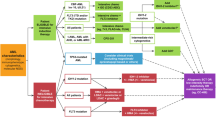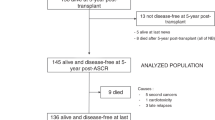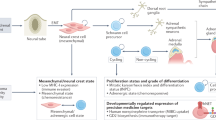Abstract
Historically, body tissues with a high rate of cell turnover, such as the bone marrow, have been most susceptible to chemotherapy-induced damage. The widespread use of hematopoietic colony-stimulating factors, as well as the development of new agents, has led to improved outcomes in many types of cancer. As a consequence, neurotoxicity has become increasingly important as a cause of dose-limiting chemotherapy toxicity. An understanding of the neurologic complications of these new agents is crucial in order to prevent irreversible neurologic injury. Moreover, chemotherapy complications that require discontinuation of a potentially effective drug need to be distinguished from other causes of neurotoxicity including the tumor itself, paraneoplasia, radiation and surgery, which may require a different therapeutic strategy. We review the prevalence, prevention, and management of important and unusual neurotoxicities related to chemotherapy and targeted agents approved by the FDA since January 1999. These agents include DNA-damaging agents such as oxaliplatin and temozolomide, microtubule poisons like ixabepilone, proteasome inhibitors (bortezomib), and signal transduction inhibitors such as imatinib, sunitinib and bevacizumab.
Key Points
-
Peripheral neuropathy often represents the dose-limiting toxicity for thalidomide, bortezomib, Abraxane®, ixabepilone, and oxaliplatin
-
Sensory neuropathy from microtubule poisons typically recovers quickly after drug discontinuation; however, neuropathy from oxaliplatin and bortezomib improves more slowly (over several months), and recovery from thalidomide neuropathy is variable and incomplete
-
The addition of temozolomide to fractionated radiotherapy is associated with an increased risk of peritumoral contrast enhancement and vasogenic edema, attributed to blood–brain barrier breakdown that mimics early tumor progression
-
Among the new purine and pyrimidine analogs, nelarabine commonly produces peripheral neuropathy and encephalopathy, and liposomal cytarabine routinely causes arachnoiditis warranting corticosteroid prophylaxis
-
Muscle cramps and myalgias frequently arise in patients receiving imatinib and generally respond to supportive measures; rhabdomyolysis is rarely seen
-
All drugs that target the VEGF pathway convey a small risk of producing reversible posterior encephalopathy syndrome, probably because they all are capable of producing hypertension
This is a preview of subscription content, access via your institution
Access options
Subscribe to this journal
Receive 12 print issues and online access
$209.00 per year
only $17.42 per issue
Buy this article
- Purchase on Springer Link
- Instant access to full article PDF
Prices may be subject to local taxes which are calculated during checkout


Similar content being viewed by others
References
Posner, J. B. Neurologic Complications of Cancer (F. A. Davis Company, Philadelphia, 1995).
Schiff, D. & Wen, P. Y. Cancer Neurology in Clinical Practice (Humana Press, Totowa, 2002).
Roche, H. et al. Phase II clinical trial of ixabepilone (BMS-247550), an epothilone B analog, as first-line therapy in patients with metastatic breast cancer previously treated with anthracycline chemotherapy. J. Clin. Oncol. 25, 3415–3420 (2007).
Perez, E. A. et al. Efficacy and safety of ixabepilone (BMS-247550) in a phase II study of patients with advanced breast cancer resistant to an anthracycline, a taxane, and capecitabine. J. Clin. Oncol. 25, 3407–3414 (2007).
Aghajanian, C. et al. Phase I study of the novel epothilone analog ixabepilone (BMS-247550) in patients with advanced solid tumors and lymphomas. J. Clin. Oncol. 25, 1082–1088 (2007).
Lee, J. J. et al. Changes in neurologic function tests may predict neurotoxicity caused by ixabepilone. J. Clin. Oncol. 24, 2084–2091 (2006).
Galsky, M. D. et al. Multi-institutional randomized phase II trial of the epothilone B analog ixabepilone (BMS-247550) with or without estramustine phosphate in patients with progressive castrate metastatic prostate cancer. J. Clin. Oncol. 23, 1439–1446 (2005).
Rook, J., Rosser, T., Fangusaro, J. & Finlay, J. Acute transient encephalopathy following paclitaxel treatment in an adolescent with a recurrent suprasellar germinoma. Pediatr. Blood Cancer 50, 699–700 (2008).
Ziske, C. G. et al. Acute transient encephalopathy after paclitaxel infusion: report of three cases. Ann. Oncol. 13, 629–631 (2002).
Nieto, Y. et al. Acute encephalopathy: a new toxicity associated with high-dose paclitaxel. Clin. Cancer Res. 5, 501–506 (1999).
Ibrahim, N. K. et al. Multicenter phase II trial of ABI-007, an albumin-bound paclitaxel, in women with metastatic breast cancer. J. Clin. Oncol. 23, 6019–6026 (2005).
Gradishar, W. J. et al. Phase III trial of nanoparticle albumin-bound paclitaxel compared with polyethylated castor oil-based paclitaxel in women with breast cancer. J. Clin. Oncol. 23, 7794–7803 (2005).
Ibrahim, N. K. et al. Phase I and pharmacokinetic study of ABI-007, a cremophor-free, protein-stabilized, nanoparticle formulation of paclitaxel. Clin. Cancer Res. 8, 1038–1044 (2002).
Kelly, H. & Goldberg, R. M. Systemic therapy for metastatic colorectal cancer: current options, current evidence. J. Clin. Oncol. 23, 4553–4560 (2005).
Schmoll, H.-J. & Cassidy, J. Integrating oxaliplatin into the management of colorectal cancer. Oncologist 6, 24–28 (2001).
Lehky, T. J., Leonard, G. D., Wilson, R. H., Grem, J. L. & Floeter, M. K. Oxaliplatin-induced neurotoxicity: acute hyperexcitability and chronic neuropathy. Muscle Nerve 29, 387–392 (2004).
Grothey, A. Oxaliplatin-safety profile: neurotoxicity. Semin. Oncol. 30, 5–13 (2003).
Wilson, R. H. et al. Acute oxaliplatin-induced peripheral nerve hyperexcitability. J. Clin. Oncol. 20, 1767–1774 (2002).
Cersosimo, R. J. Oxaliplatin-associated neuropathy: a review. Ann. Pharmacother. 39, 128–135 (2005).
Krishnan, A. V., Goldstein, D., Friedlander, M. & Kiernan, M. C. Oxaliplatin-induced neurotoxicity and the development of neuropathy. Muscle Nerve 32, 51–60 (2005).
Taieb, S., Trillet-Lenoir, V., Rambaud, L., Descos, L. & Freyer, G. Lhermitte sign and urinary retention: atypical presentation of oxaliplatin neurotoxicity in four patients. Cancer 94, 2434–2440 (2002).
Gilles-Amar, V. et al. Evolution of severe sensory neuropathy with oxaliplatin combined to the bimonthly 48h leucovorin (LV) and 5-fluorouracil (5FU) regimens (FOLFOX) in metastatic colorectal cancer [abstract]. Proc. Am. Soc. Clin. Oncol. 18 246a (1999).
von Delius, S. et al. Carbamazepine for prevention of oxaliplatin-related neurotoxicity in patients with advanced colorectal cancer: final results of a randomised, controlled, multicenter phase II study. Invest. New Drugs 25, 173–180 (2007).
Argyriou, A. A. et al. Efficacy of oxcarbazepine for prophylaxis against cumulative oxaliplatin-induced neuropathy. Neurology 67, 2253–2255 (2006).
Cascinu, S. et al. Neuroprotective effect of reduced glutathione on oxaliplatin-based chemotherapy in advanced colorectal cancer: a randomized, double-blind, placebo-controlled trial. J. Clin. Oncol. 20, 3478–3483 (2002).
Grolleau, F. et al. A possible explanation for a neurotoxic effect of the anticancer agent oxaliplatin on neuronal voltage-gated sodium channels. J. Neurophysiol. 85, 2293–2297 (2001).
Gamelin, L. et al. Prevention of oxaliplatin-related neurotoxicity by calcium and magnesium infusions: a retrospective study of 161 patients receiving oxaliplatin combined with 5-fluorouracil and leucovorin for advanced colorectal cancer. Clin. Cancer Res. 10, 4055–4061 (2004).
Hochster, H. S., Grothey, A. & Childs, B. H. Use of calcium and magnesium salts to reduce oxaliplatin-related neurotoxicity. J. Clin. Oncol. 25, 4028–4029 (2007).
Hochster, H. S. & Grothey, A. In reply. J. Clin. Oncol. 26, 1189 (2008).
Nikcevich, D. A. et al. Effect of intravenous calcium and magnesium (IV CaMg) on oxaliplatin-induced sensory neurotoxicity (sNT) in adjuvant colon cancer: Results of the phase III placebo-controlled, double-blind NCCTG trial N04C7 [abstract]. ASCO Meeting Abstracts 26, 4009 (2008).
Patel, M., McCully, C., Godwin, K. & Balis, F. M. Plasma and cerebrospinal fluid pharmacokinetics of intravenous temozolomide in non-human primates. J. Neurooncol. 61, 203–207 (2003).
de Wit, M. C., de Bruin, H. G., Eijkenboom, W., Sillevis Smitt, P. A. & van den Bent, M. J. Immediate post-radiotherapy changes in malignant glioma can mimic tumor progression. Neurology 63, 535–537 (2004).
Brandes, A. A. et al. MGMT promoter methylation status can predict the incidence and outcome of pseudoprogression after concomitant radiochemotherapy in newly diagnosed glioblastoma patients. J. Clin. Oncol. 26, 2192–2197 (2008).
Taal, W. et al. Incidence of early pseudo-progression in a cohort of malignant glioma patients treated with chemoirradiation with temozolomide. Cancer 113, 405–410 (2008).
Mason, W. P. et al. Canadian recommendations for the treatment of glioblastoma multiforme. Curr. Oncol. 14, 110–117 (2007).
Berg, S. L. et al. Phase II study of nelarabine (compound 506U78) in children and young adults with refractory T-cell malignancies: a report from the Children's Oncology Group. J. Clin. Oncol. 23, 3376–3382 (2005).
Cohen, M. H., Johnson, J. R., Justice, R. & Pazdur, R. FDA drug approval summary: nelarabine (Arranon) for the treatment of T-cell lymphoblastic leukemia/lymphoma. Oncologist 13, 709–714 (2008).
Berg, S. L. et al. Plasma and cerebrospinal fluid pharmacokinetics of nelarabine in nonhuman primates. Cancer Chemother. Pharmacol. 59, 743–747 (2007).
Berg, S. L. et al. Plasma and cerebrospinal fluid pharmacokinetics of clofarabine in nonhuman primates. Clin. Cancer Res. 11, 5981–5983 (2005).
Faderl, S. et al. A randomized study of clofarabine versus clofarabine plus low-dose cytarabine as front-line therapy for patients aged 60 years and older with acute myeloid leukemia and high-risk myelodysplastic syndrome. Blood 112, 1638–1645 (2008).
Kantarjian, H. M., Jeha, S., Gandhi, V., Wess, M. & Faderl, S. Clofarabine: past, present, and future. Leuk. Lymphoma 48, 1922–1930 (2007).
Glantz, M. J. et al. Randomized trial of a slow-release versus a standard formulation of cytarabine for the intrathecal treatment of lymphomatous meningitis. J. Clin. Oncol. 17, 3110–3116 (1999).
Jabbour, E. et al. Neurologic complications associated with intrathecal liposomal cytarabine given prophylactically in combination with high-dose methotrexate and cytarabine to patients with acute lymphocytic leukemia. Blood 109, 3214–3218 (2007).
Adams, J. The proteasome: a suitable antineoplastic target. Nat. Rev. Cancer 4, 349–360 (2004).
Richardson, P. G. et al. Frequency, characteristics, and reversibility of peripheral neuropathy during treatment of advanced multiple myeloma with bortezomib. J. Clin. Oncol. 24, 3113–3120 (2006).
Richardson, P. G. et al. Bortezomib or high-dose dexamethasone for relapsed multiple myeloma. N. Engl. J. Med. 352, 2487–2498 (2005).
Oaklander, A. L. et al. Multiple myeloma polyneuropathy before and after initial chemotherapy with single-agent bortezomib. In 131st Annual Meeting of the American Neurological Association (Chicago, IL, 2006).
Richardson, P. G. et al. Extended follow-up of a phase 3 trial in relapsed multiple myeloma: final time-to-event results of the APEX trial. Blood 110, 3557–3560 (2007).
Cavaletti, G. et al. Bortezomib-induced peripheral neurotoxicity: a neurophysiological and pathological study in the rat. Exp. Neurol. 204, 317–325 (2007).
Vredenburgh, J. J. et al. Bevacizumab plus irinotecan in recurrent glioblastoma multiforme. J. Clin. Oncol. 25, 4722–4729 (2007).
Cloughesy, T. F. et al. A phase II, randomized, non-comparative clinical trial of the effect of bevacizumab (BV) alone or in combination with irinotecan (CPT) on 6-month progression free survival (PFS6) in recurrent, treatment-refractory glioblastoma (GBM) [abstract]. ASCO Meeting Abstracts 26, 2010b (2008).
Kreisl, T. N. et al. Phase II trial of single-agent bevacizumab followed by bevacizumab plus irinotecan at tumor progression in recurrent glioblastoma. J. Clin. Oncol. 27, 740–745 (2008).
Glusker, P., Recht, L. & Lane, B. Reversible posterior leukoencephalopathy syndrome and bevacizumab. N. Engl. J. Med. 354, 980–982 (2006).
Ozcan, C., Wong, S. J. & Hari, P. Reversible posterior leukoencephalopathy syndrome and bevacizumab. N. Engl. J. Med. 354, 980–982 (2006).
Allen, J. A., Adlakha, A. & Bergethon, P. R. Reversible posterior leukoencephalopathy syndrome after bevacizumab/FOLFIRI regimen for metastatic colon cancer. Arch. Neurol. 63, 1475–1478 (2006).
Koopman, M., Muller, E. W. & Punt, C. J. Reversible posterior leukoencephalopathy syndrome caused by bevacizumab: report of a case. Dis. Colon Rectum 51, 1425–1426 (2008).
Govindarajan, R., Adusumilli, J., Baxter, D. L., El-Khoueiry, A. & Harik, S. I. Reversible posterior leukoencephalopathy syndrome induced by RAF kinase inhibitor BAY 43–9006. J. Clin. Oncol. 24, e48 (2006).
Kapiteijn, E., Brand, A., Kroep, J. & Gelderblom, H. Sunitinib induced hypertension, thrombotic microangiopathy and reversible posterior leukencephalopathy syndrome. Ann. Oncol. 18, 1745–1747 (2007).
Martin, G., Bellido, L. & Cruz, J. J. Reversible posterior leukoencephalopathy syndrome induced by sunitinib. J. Clin. Oncol. 25, 3559 (2007).
Gijtenbeek, J. M., van den Bent, M. J. & Vecht, C. J. Cyclosporine neurotoxicity: a review. J. Neurol. 246, 339–346 (1999).
van der Veldt, A. A., van den Eertwegh, A. J., Hoekman, K., Barkhof, F. & Boven, E. Reversible cognitive disorders after sunitinib for advanced renal cell cancer in patients with preexisting arteriosclerotic leukoencephalopathy. Ann. Oncol. 18, 1747–1750 (2007).
Kilickap, S., Abali, H. & Celik, I. Bevacizumab, bleeding, thrombosis, and warfarin. J. Clin. Oncol. 21, 3542 (2003).
Johnson, D. H. et al. Randomized phase II trial comparing bevacizumab plus carboplatin and paclitaxel with carboplatin and paclitaxel alone in previously untreated locally advanced or metastatic non-small-cell lung cancer. J. Clin. Oncol. 22, 2184–2191 (2004).
Carden, C. P., Larkin, J. M. & Rosenthal, M. A. What is the risk of intracranial bleeding during anti-VEGF therapy? Neuro Oncol. 10, 624–630 (2008).
Pouessel, D. & Culine, S. High frequency of intracerebral hemorrhage in metastatic renal carcinoma patients with brain metastases treated with tyrosine kinase inhibitors targeting the vascular endothelial growth factor receptor. Eur. Urol. 53, 376–381 (2008).
Nghiemphu, P. L., Green, R. M., Pope, W. B., Lai, A. & Cloughesy, T. F. Safety of anticoagulation use and bevacizumab in patients with glioma. Neuro Oncol. 10, 355–360 (2008).
Kantarjian, H. et al. Hematologic and cytogenetic responses to imatinib mesylate in chronic myelogenous leukemia. N. Engl. J. Med. 346, 645–652 (2002).
Deininger, M. W., O'Brien, S. G., Ford, J. M. & Druker, B. J. Practical management of patients with chronic myeloid leukemia receiving imatinib. J. Clin. Oncol. 21, 1637–1647 (2003).
Penel, N., Blay, J. Y. & Adenis, A. Imatinib as a possible cause of severe rhabdomyolysis. N. Engl. J. Med. 358, 2746–2747 (2008).
Song, K. W. et al. Subdural hematomas during CML therapy with imatinib mesylate. Leuk. Lymphoma 45, 1633–1636 (2004).
Pollack, I. F. et al. Phase I trial of imatinib in children with newly diagnosed brainstem and recurrent malignant gliomas: a Pediatric Brain Tumor Consortium report. Neuro Oncol. 9, 145–160 (2007).
Wen, P. Y. et al. Phase I/II study of imatinib mesylate for recurrent malignant gliomas: North American Brain Tumor Consortium Study 99–08. Clin. Cancer Res. 12, 4899–4907 (2006).
Ghobrial, I. M. & Rajkumar, S. V. Management of thalidomide toxicity. J. Support. Oncol. 1, 194–205 (2003).
Glasmacher, A. et al. A systematic review of phase-II trials of thalidomide monotherapy in patients with relapsed or refractory multiple myeloma. Br. J. Haematol. 132, 584–593 (2006).
Plasmati, R. et al. Neuropathy in multiple myeloma treated with thalidomide: a prospective study. Neurology 69, 573–581 (2007).
Cavaletti, G. et al. Thalidomide sensory neurotoxicity: a clinical and neurophysiologic study. Neurology 62, 2291–2293 (2004).
Chaudhry, V. et al. Thalidomide-induced neuropathy. Neurology 59, 1872–1875 (2002).
Briani, C. et al. Thalidomide neurotoxicity: prospective study in patients with lupus erythematosus. Neurology 62, 2288–2290 (2004).
Mileshkin, L. et al. Development of neuropathy in patients with myeloma treated with thalidomide: patterns of occurrence and the role of electrophysiologic monitoring. J. Clin. Oncol. 24, 4507–4514 (2006).
Tosi, P. et al. Neurological toxicity of long-term (>1 yr) thalidomide therapy in patients with multiple myeloma. Eur. J. Haematol. 74, 212–216 (2005).
Bastuji-Garin, S. et al. Incidence and risk factors for thalidomide neuropathy: a prospective study of 135 dermatologic patients. J. Invest. Dermatol. 119, 1020–1026 (2002).
Offidani, M. et al. Common and rare side-effects of low-dose thalidomide in multiple myeloma: focus on the dose-minimizing peripheral neuropathy. Eur. J. Haematol. 72, 403–409 (2004).
Sharma, R. A. et al. Toxicity profile of the immunomodulatory thalidomide analogue, lenalidomide: phase I clinical trial of three dosing schedules in patients with solid malignancies. Eur. J. Cancer 42, 2318–2325 (2006).
Richardson, P. G. et al. Immunomodulatory drug CC-5013 overcomes drug resistance and is well tolerated in patients with relapsed multiple myeloma. Blood 100, 3063–3067 (2002).
Fine, H. A. et al. A phase I trial of lenalidomide in patients with recurrent primary central nervous system tumors. Clin. Cancer Res. 13, 7101–7106 (2007).
Dimopoulos, M. A., Kastritis, E. & Rajkumar, S. V. Treatment of plasma cell dyscrasias with lenalidomide. Leukemia 22, 1343–1353 (2008).
Terpos, E. et al. The combination of bortezomib, melphalan, dexamethasone and intermittent thalidomide is an effective regimen for relapsed/refractory myeloma and is associated with improvement of abnormal bone metabolism and angiogenesis. Leukemia 22, 2247–2256 (2008).
Pineda-Roman, M. et al. VTD combination therapy with bortezomib–thalidomide–dexamethasone is highly effective in advanced and refractory multiple myeloma. Leukemia 22, 1419–1427 (2008).
Palumbo, A. et al. Bortezomib, melphalan, prednisone, and thalidomide for relapsed multiple myeloma. Blood 109, 2767–2772 (2007).
Ciolli, S. et al. The addition of liposomal doxorubicin to bortezomib, thalidomide and dexamethasone significantly improves clinical outcome of advanced multiple myeloma. Br. J. Haematol. 141, 814–819 (2008).
Richardson, P. et al. Lenalidomide, bortezomib, and dexamethasone (Rev/Vel/Dex) in patients with relapsed or relapsed/refractory multiple myeloma (MM): preliminary results of a phase II study [abstract]. Blood (ASH Annual Meeting Abstracts) 110, 2714 (2007).
Author information
Authors and Affiliations
Corresponding author
Ethics declarations
Competing interests
D. Schiff is a Consultant for Genentech and Schering-Plough and he receives grant/research support from Genentech. P. Wen receives grant/research support from Genentech. M. van den Bent is a Consultant and receives grant/research support from Roche and Schering-Plough; he is also on the Speakers bureau for Schering-Plough.
Rights and permissions
About this article
Cite this article
Schiff, D., Wen, P. & van den Bent, M. Neurological adverse effects caused by cytotoxic and targeted therapies. Nat Rev Clin Oncol 6, 596–603 (2009). https://doi.org/10.1038/nrclinonc.2009.128
Published:
Issue Date:
DOI: https://doi.org/10.1038/nrclinonc.2009.128
This article is cited by
-
Role of inflammation and oxidative stress in chemotherapy-induced neurotoxicity
Immunologic Research (2022)
-
Exosomes: special nano-therapeutic carrier for cancers, overview on anticancer drugs
Medical Oncology (2022)
-
Mid-term treatment-related cognitive sequelae in glioma patients
Journal of Neuro-Oncology (2022)
-
Thymoquinone-chemotherapeutic combinations: new regimen to combat cancer and cancer stem cells
Naunyn-Schmiedeberg's Archives of Pharmacology (2020)
-
Neurological complications of pediatric cancer
Cancer and Metastasis Reviews (2020)



